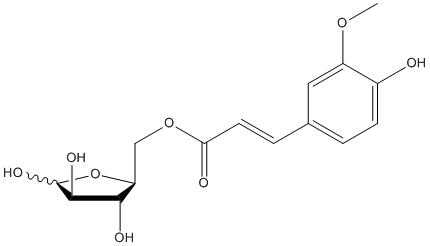Ara1F
General
Type : Glycoside || Feruloyl
Chemical_Nomenclature : [(2S,3R,4R)-3,4,5-trihydroxyoxolan-2-yl]methyl (E)-3-(4-hydroxy-3-methoxyphenyl)prop-2-enoate
Canonical SMILES : COC1=C(C=CC(=C1)C=CC(=O)OCC2C(C(C(O2)O)O)O)O
InChI : InChI=1S\/C15H18O8\/c1-21-10-6-8(2-4-9(10)16)3-5-12(17)22-7-11-13(18)14(19)15(20)23-11\/h2-6,11,13-16,18-20H,7H2,1H3\/b5-3+\/t11-,13-,14+,15?\/m0\/s1
InChIKey : BDEXCUQHBTVULQ-PQRDISFUSA-N
Other name(s) : F-A, 5-O-trans-feruloyl-l-arabinofuranose, 5-O-(trans-feruloyl)-L-arabinofuranose, 5-o-feruloyl-l-arabinofuranose, CHEBI:62281, SCHEMBL18060061, 5-O-[(2E)-3-(4-hydroxy-3-methoxyphenyl)prop-2-enoyl]-L-arabinofuranose
MW : 326.30
Formula : C15H18O8
CAS_number :
PubChem :
UniChem :
Iuphar :

Target
Families : Chlorophyllase
References (4)
| Title : 2D-HSQC-NMR-Based Screening of Feruloylated Side-Chains of Cereal Grain Arabinoxylans - Schendel_2022_Front.Plant.Sci_13_951705 |
| Author(s) : Schendel RR , Bunzel M |
| Ref : Front Plant Sci , 13 :951705 , 2022 |
| Abstract : Schendel_2022_Front.Plant.Sci_13_951705 |
| ESTHER : Schendel_2022_Front.Plant.Sci_13_951705 |
| PubMedSearch : Schendel_2022_Front.Plant.Sci_13_951705 |
| PubMedID: 35874025 |
| Title : A type D ferulic acid esterase from Streptomyces werraensis affects the volume of wheat dough pastries - Schulz_2018_Appl.Microbiol.Biotechnol_102_1269 |
| Author(s) : Schulz K , Nieter A , Scheu AK , Copa-Patino JL , Thiesing D , Popper L , Berger RG |
| Ref : Applied Microbiology & Biotechnology , 102 :1269 , 2018 |
| Abstract : Schulz_2018_Appl.Microbiol.Biotechnol_102_1269 |
| ESTHER : Schulz_2018_Appl.Microbiol.Biotechnol_102_1269 |
| PubMedSearch : Schulz_2018_Appl.Microbiol.Biotechnol_102_1269 |
| PubMedID: 29188331 |
| Gene_locus related to this paper: 9actn-SwFAED |
| Title : Characterization of Cinnamoyl Esterases from Different Lactobacilli and Bifidobacteria - Fritsch_2017_Curr.Microbiol_74_247 |
| Author(s) : Fritsch C , Jansch A , Ehrmann MA , Toelstede S , Vogel RF |
| Ref : Curr Microbiol , 74 :247 , 2017 |
| Abstract : Fritsch_2017_Curr.Microbiol_74_247 |
| ESTHER : Fritsch_2017_Curr.Microbiol_74_247 |
| PubMedSearch : Fritsch_2017_Curr.Microbiol_74_247 |
| PubMedID: 27999938 |
| Gene_locus related to this paper: limf3-b2gdc2 , lache-u6f2k7 , bifa0-b8du06 , lacac-q5fi30 , lacga-q040s2 , lacpl-LP.2953 , lacre-q2bvr2 |
| Title : Purification and characterization of a feruloyl esterase from the intestinal bacterium Lactobacillus acidophilus - Wang_2004_Appl.Environ.Microbiol_70_2367 |
| Author(s) : Wang X , Geng X , Egashira Y , Sanada H |
| Ref : Applied Environmental Microbiology , 70 :2367 , 2004 |
| Abstract : Wang_2004_Appl.Environ.Microbiol_70_2367 |
| ESTHER : Wang_2004_Appl.Environ.Microbiol_70_2367 |
| PubMedSearch : Wang_2004_Appl.Environ.Microbiol_70_2367 |
| PubMedID: 15066833 |